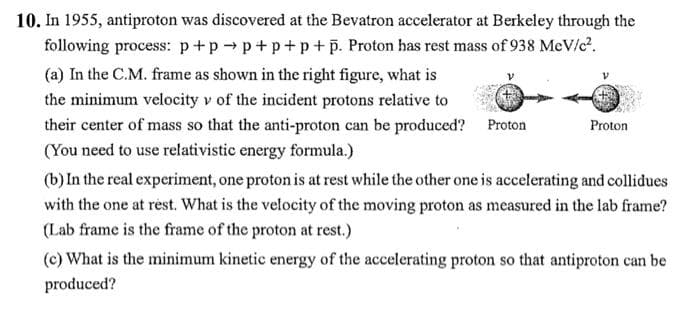10. In 1955, antiproton was discovered at the Bevatron accelerator at Berkeley through the following process: p+pp+p+p+p. Proton has rest mass of 938 MeV/c². (a) In the C.M. frame as shown in the right figure, what is the minimum velocity v of the incident protons relative to their center of mass so that the anti-proton can be produced? Proton (You need to use relativistic energy formula.) Proton (b) In the real experiment, one proton is at rest while the other one is accelerating and collidues with the one at rest. What is the velocity of the moving proton as measured in the lab frame? (Lab frame is the frame of the proton at rest.) (c) What is the minimum kinetic energy of the accelerating proton so that antiproton can be produced?
10. In 1955, antiproton was discovered at the Bevatron accelerator at Berkeley through the following process: p+pp+p+p+p. Proton has rest mass of 938 MeV/c². (a) In the C.M. frame as shown in the right figure, what is the minimum velocity v of the incident protons relative to their center of mass so that the anti-proton can be produced? Proton (You need to use relativistic energy formula.) Proton (b) In the real experiment, one proton is at rest while the other one is accelerating and collidues with the one at rest. What is the velocity of the moving proton as measured in the lab frame? (Lab frame is the frame of the proton at rest.) (c) What is the minimum kinetic energy of the accelerating proton so that antiproton can be produced?
Physics for Scientists and Engineers, Technology Update (No access codes included)
9th Edition
ISBN:9781305116399
Author:Raymond A. Serway, John W. Jewett
Publisher:Raymond A. Serway, John W. Jewett
Chapter39: Relativity
Section: Chapter Questions
Problem 39.52P
Related questions
Question

Transcribed Image Text:10. In 1955, antiproton was discovered at the Bevatron accelerator at Berkeley through the
following process: p+pp+p+p+p. Proton has rest mass of 938 MeV/c².
(a) In the C.M. frame as shown in the right figure, what is
the minimum velocity v of the incident protons relative to
their center of mass so that the anti-proton can be produced? Proton
(You need to use relativistic energy formula.)
Proton
(b) In the real experiment, one proton is at rest while the other one is accelerating and collidues
with the one at rest. What is the velocity of the moving proton as measured in the lab frame?
(Lab frame is the frame of the proton at rest.)
(c) What is the minimum kinetic energy of the accelerating proton so that antiproton can be
produced?
Expert Solution
This question has been solved!
Explore an expertly crafted, step-by-step solution for a thorough understanding of key concepts.
This is a popular solution!
Trending now
This is a popular solution!
Step by step
Solved in 4 steps

Knowledge Booster
Learn more about
Need a deep-dive on the concept behind this application? Look no further. Learn more about this topic, physics and related others by exploring similar questions and additional content below.Recommended textbooks for you

Physics for Scientists and Engineers, Technology …
Physics
ISBN:
9781305116399
Author:
Raymond A. Serway, John W. Jewett
Publisher:
Cengage Learning


College Physics
Physics
ISBN:
9781285737027
Author:
Raymond A. Serway, Chris Vuille
Publisher:
Cengage Learning

Physics for Scientists and Engineers, Technology …
Physics
ISBN:
9781305116399
Author:
Raymond A. Serway, John W. Jewett
Publisher:
Cengage Learning


College Physics
Physics
ISBN:
9781285737027
Author:
Raymond A. Serway, Chris Vuille
Publisher:
Cengage Learning

College Physics
Physics
ISBN:
9781305952300
Author:
Raymond A. Serway, Chris Vuille
Publisher:
Cengage Learning

College Physics
Physics
ISBN:
9781938168000
Author:
Paul Peter Urone, Roger Hinrichs
Publisher:
OpenStax College

University Physics Volume 3
Physics
ISBN:
9781938168185
Author:
William Moebs, Jeff Sanny
Publisher:
OpenStax